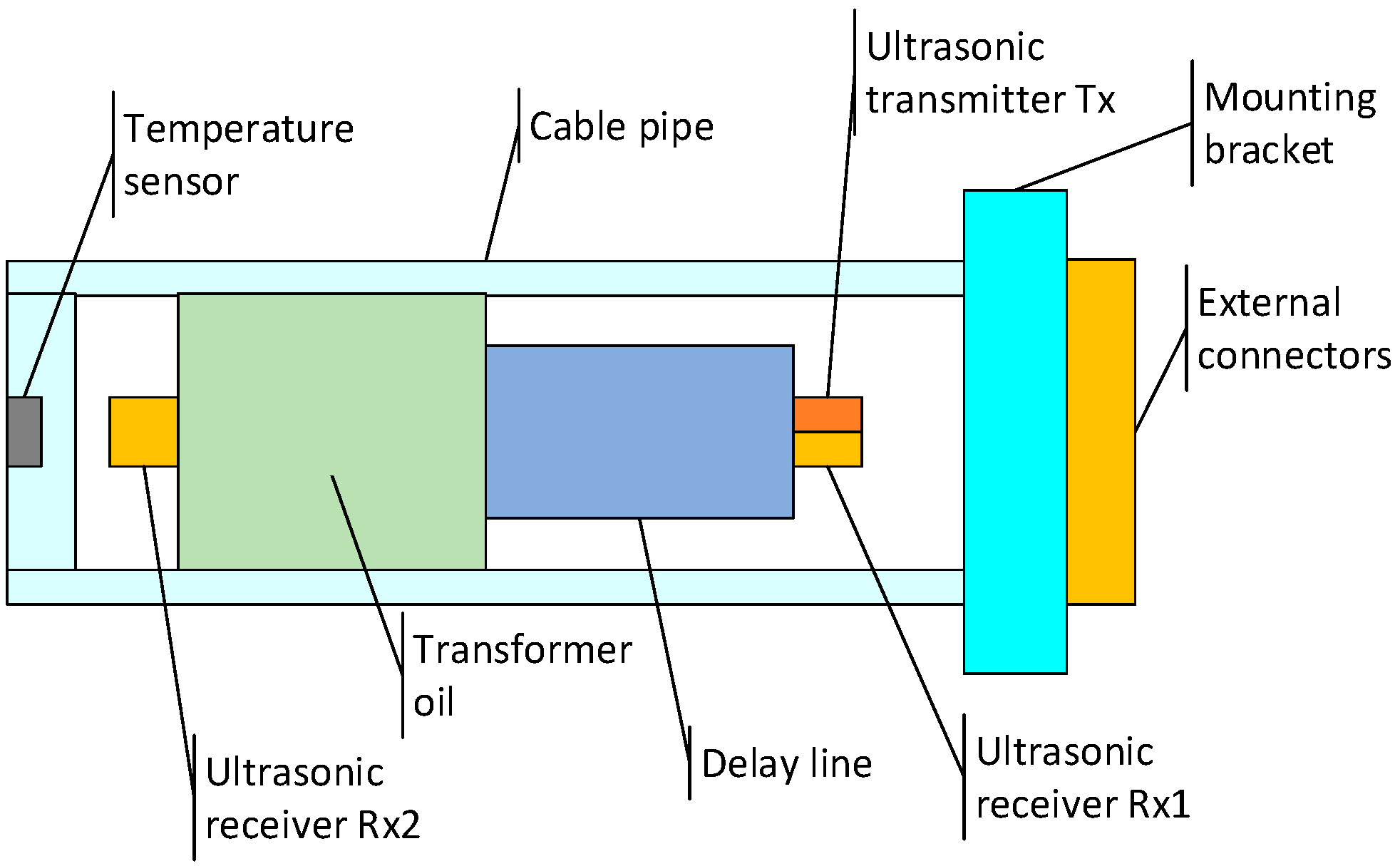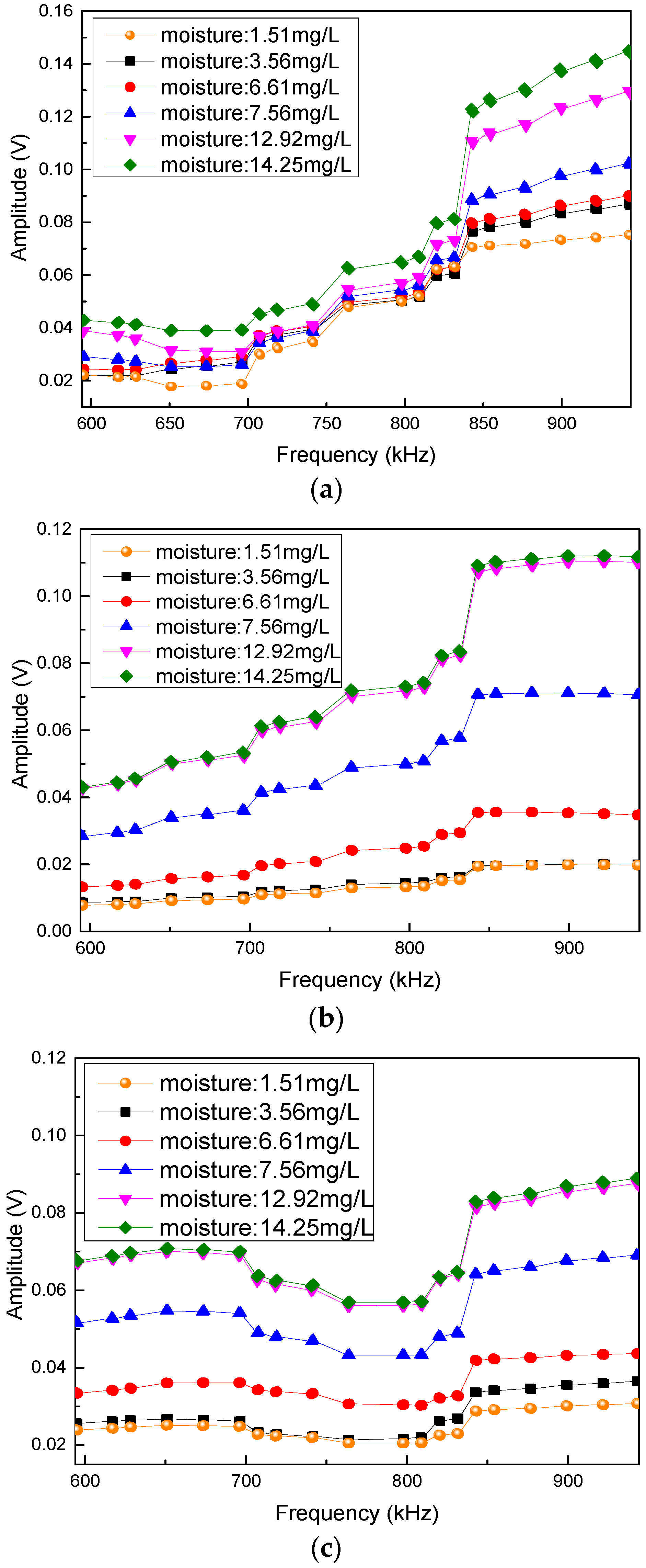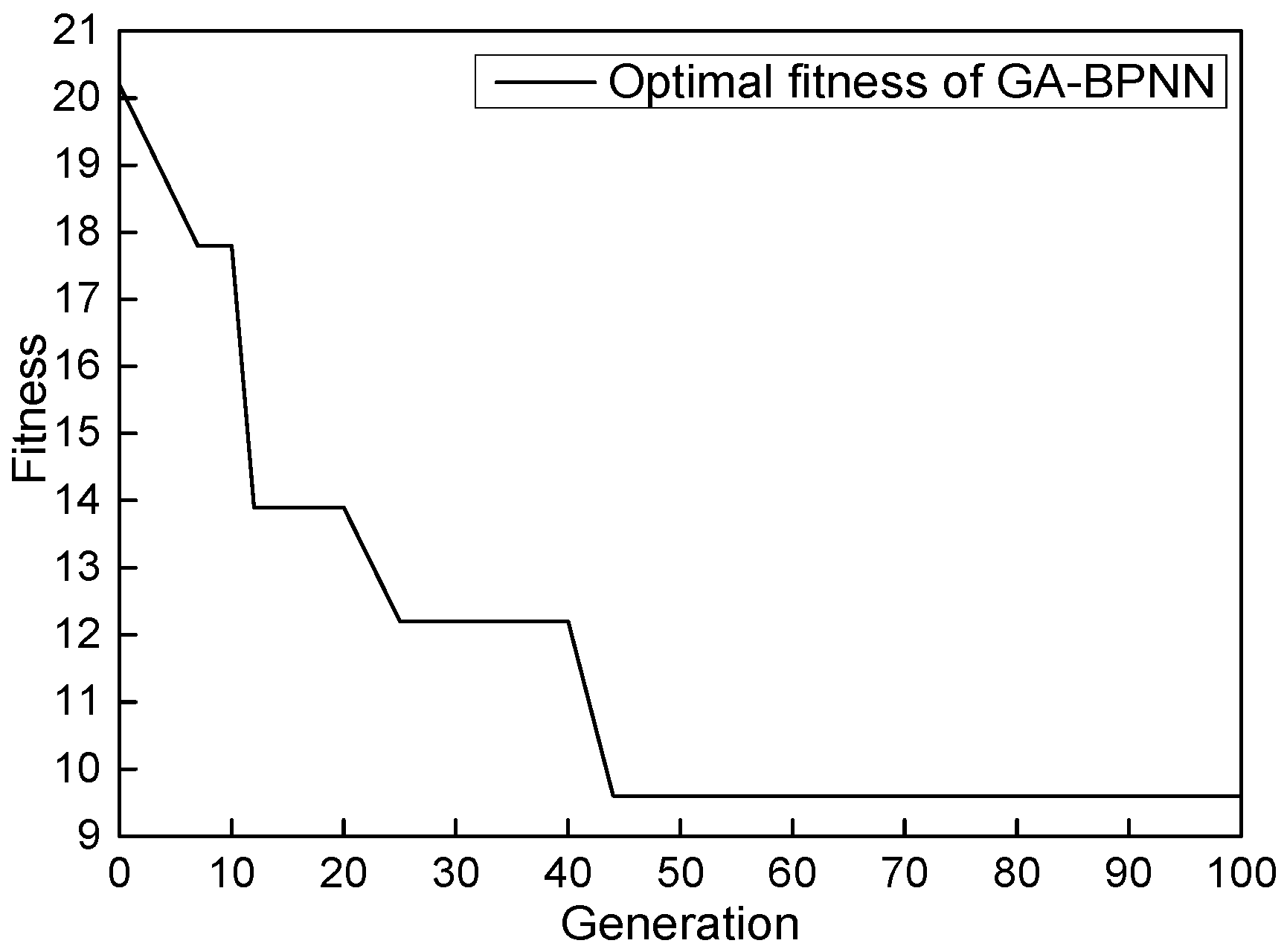Detection of Water Content in Transformer Oil Using Multi Frequency Ultrasonic with PCA-GA-BPNN †
Abstract
:1. Introduction
2. MFU Testing System
3. Experimental Results
4. Artificial Neural Network
4.1. Principal Component Analysis
4.2. BP Neural Network
4.3. Genetic Algorithm
4.4. PCA-GA-BPNN Prediction Model
5. Results and Discussion
6. Conclusions
Author Contributions
Funding
Conflicts of Interest
References
- Lundgaard, L.; Hansen, W.; Ingebrigtsen, S. Ageing of mineral oil impregnated cellulose by acid catalysis. IEEE Trans. Dielectr. Electr. Insul. 2008, 15, 540–546. [Google Scholar] [CrossRef]
- Pradhan, M. Assessment of the status of insulation during thermal stress accelerated experiments on transformer prototypes. IEEE Trans. Dielectr. Electr. Insul. 2006, 13, 227–237. [Google Scholar] [CrossRef]
- Zhou, Q.; Chen, W.G.; Xu, L.N.; Kumar, R.; Gui, Y.G.; Zhao, Z.Y.; Tang, C.; Zhu, S.P. Highly sensitive carbon monoxide (CO) gas sensors based on Ni and Zn doped SnO2 nanomaterials. Ceram. Int. 2018, 44, 4392–4399. [Google Scholar] [CrossRef]
- Rubio-Serrano, J.; Rojas-Moreno, M.V.; Posada, J.; Martínez-Tarifa, J.M.; Robles, G.; Garcia-Souto, J.A. Electro-acoustic detection, identification and location of partial discharge sources in oil-paper insulation systems. IEEE Trans. Dielectr. Electr. Insul. 2012, 19, 1569–1578. [Google Scholar] [CrossRef]
- Martin, D.; Perkasa, C.; Lelekakis, N. Measuring Paper Water Content of Transformers: A New Approach Using Cellulose Isotherms in Nonequilibrium Conditions. IEEE Trans. Power Deliv. 2013, 28, 1433–1439. [Google Scholar] [CrossRef]
- Jadav, R.B.; Ekanayake, C.; Saha, T.K. Understanding the impact of moisture and ageing of transformer insulation on frequency domain spectroscopy. IEEE Trans. Dielectr. Electr. Insul. 2014, 21, 369–379. [Google Scholar] [CrossRef]
- Zhou, Q.; Xu, L.N.; Ahmad, U.; Chen, W.G.; Rajesh, K. Pt nanoparticles decorated SnO2 nanoneedles for efficient CO gas sensing applications. Sens. Actuators B 2018, 256, 656–664. [Google Scholar] [CrossRef]
- Szepes, L.; Torkos, K.; Dobo, R.; Szekely, A. A New Analytical Method for the Determination of the Water Content of Transformer Oils. IEEE Trans. Electr. Insul. 1982, 17, 345–349. [Google Scholar] [CrossRef]
- Martin, D.; Saha, T.; Perkasa, C.; Lelekakis, N.; Gradnik, T. Fundamental concepts of using water activity probes to assess transformer insulation water content. IEEE Electr. Insul. Mag. 2016, 32, 9–16. [Google Scholar] [CrossRef]
- Rodríguezrodríguez, J.H.; Martínezpiñón, F.; ÁlvarezChávez; José, A.; Jaramillo-Vigueras, D.; Robles-Pimentel, E.G. Direct optical techniques for the measurement of water content in oil–paper insulation in power transformers. Meas. Sci. Technol. 2011, 22, 2572–2575. [Google Scholar]
- Sarfi, V.; Mohajeryami, S.; Majzoobi, A. Estimation of water content in a power transformer using moisture dynamic measurement of its oil. High Volt. 2017, 2, 11–16. [Google Scholar] [CrossRef]
- Martin, D.; Krause, O.; Saha, T. Measuring the Pressboard Water Content of Transformers Using Cellulose Isotherms and the Frequency Components of Water Migration. IEEE Trans. Power Deliv. 2017, 32, 1314–1320. [Google Scholar] [CrossRef]
- Belanger, G.; Duval, M. Monitor for Hydrogen Dissolved in Transformer Oil. IEEE Trans. Electr. Insul. 2007, 12, 334–340. [Google Scholar] [CrossRef]
- Yang, Y. Fuzzy Set Pair Analysis in Transformer Condition Evaluation. Electr. Eng. 2013, 14, 30–35. [Google Scholar]
- Lesieutre, B.C.; Hagman, W.H.; Kirtley, J.L. An improved transformer top oil temperature model for use in an on-line monitoring and diagnostic system. IEEE Trans. Power Deliv. 1997, 12, 249–256. [Google Scholar] [CrossRef] [Green Version]
- Ben, B.S.; Yang, S.H.; Ratnam, C.; Ben, B.A. Ultrasonic based structural damage detection using combined finite element and model Lamb wave propagation parameters in composite materials. Int. J. Adv. Manuf. Technol. 2013, 67, 1847–1856. [Google Scholar] [CrossRef]
- Xie, Q.; Tao, J.; Wang, Y.; Geng, J.; Cheng, S.; Lü, F. Use of ultrasonic array method for positioning multiple partial discharge sources in transformer oil. Rev. Sci. Instrum. 2014, 85, 084705. [Google Scholar]
- Kweon, D.J.; Chin, S.B.; Kwak, H.R.; Kim, J.C.; Song, K.B. The analysis of ultrasonic signals by partial discharge and noise from the transformer. IEEE Trans. Power Deliv. 2005, 20, 1976–1983. [Google Scholar] [CrossRef]
- Khyam, M.O.; Ge, S.S.; Li, X.; Pickering, M.R. Highly Accurate Time-of-Flight Measurement Technique based on Phase-correlation for Ultrasonic Ranging. IEEE Sens. J. 2017, 17, 434–443. [Google Scholar] [CrossRef]
- Jacquemart, P. A progressive method of medical examination: Ultrasonic echotomography. Inf. Dent. 1974, 56, 137–140. [Google Scholar]
- Tang, L.; Luo, R.; Min, D.; Su, J. Study of Partial Discharge Localization Using Ultrasonics in Power Transformer Based on Particle Swarm Optimization. IEEE Trans. Dielectr. Electr. Insul. 2008, 15, 492–495. [Google Scholar]
- Awad, T.S.; Moharram, H.A.; Shaltout, O.E.; Asker, D.; Youssef, M.M. Applications of ultrasound in analysis, processing and quality control of food: A review. Food Res. Int. 2012, 48, 410–427. [Google Scholar] [CrossRef]
- Nie, P.; Chen, X. Prediction of tool VB value based on PCA and BP neural network. J. Beijing Univ. Aeronaut. Astronaut. 2011, 37, 364–367. [Google Scholar]
- Fei, H.; Zhang, L. Prediction model of end-point phosphorus content in BOF steelmaking process based on PCA and BP neural network. J. Process Control 2018, 66, 51–58. [Google Scholar]
- Ding, S.; Su, C.; Yu, J. An optimizing BP neural network algorithm based on genetic algorithm. Artif. Intell. Rev. 2011, 36, 153–162. [Google Scholar] [CrossRef]
- Nair, V.V.; Dhar, H.; Kumar, S.; Thalla, A.K.; Mukherjee, S.; Wong, J.W.C. Artificial neural network based modeling to evaluate methane yield from biogas in alaboratory-scale anaerobic bioreactor. Bioresour. Technol. 2016, 217, 90–99. [Google Scholar] [CrossRef]
- Fu, Z.M.; Mo, J.H. Springback prediction of high-strength sheet metal under air bending forming and tool design based on GA–BPNN. Int. J. Adv. Manuf. Technol. 2011, 53, 473–483. [Google Scholar] [CrossRef]
- Liu, K.; Guo, W.; Shen, X.; Zhongfu, T. Research on the Forecast Model of Electricity Power Industry Loan Based on GA-BP Neural Network. Energy Procedia 2012, 14, 1918–1924. [Google Scholar] [Green Version]
- Wang, S.; Na, Z.; Lei, W.; Wang, Y. Wind speed forecasting based on the hybrid ensemble empirical mode decomposition and GA-BP neural network method. Renew. Energy 2016, 94, 629–636. [Google Scholar] [CrossRef]
- Liang, Y.; Chao, R.; Wang, H.; Huang, Y.B.; Zheng, Z.T. Research on soil moisture inversion method based on GA-BP neural network model. Int. J. Remote Sens. 2018, 1–17. [Google Scholar] [CrossRef]
- Zhu, Y.H.; Zhuang, D.Z. Application and Study of BP Neural Network and Genetic Algorithm for Optimizational Parameters Based on MATLAB. Appl. Mech. Mater. 2013, 325–326, 1726–1729. [Google Scholar] [CrossRef]
- Dayhof, J.E.; Deleo, J.M. Artificial neural networks. Cancer 2001, 91, 1615–1634. [Google Scholar] [CrossRef]
- Beigy, H.; Rezameybodi, M. A learning automata-based algorithm for determination of the number of hidden units for three-layer neural networks. Int. J. Syst. Sci. 2009, 40, 101–118. [Google Scholar] [CrossRef]
- Murata, N.; Yoshizawa, S.; Amari, S. Network information criterion-determining the number of hidden units for an artificial neural network model. IEEE Trans. Neural Netw. 1994, 5, 865–872. [Google Scholar] [CrossRef] [Green Version]











| Sample Number | Test Value | BPNN | GA-BPNN | PCA-GA-BPNN | |||
|---|---|---|---|---|---|---|---|
| Predicted Value | Error | Predicted Value | Error | Predicted Value | Error | ||
| 1 | 14.3 | 16.1 | 12.59% | 13.1 | 8.39% | 13.56 | 5.17% |
| 2 | 11.32 | 13.22 | 16.78% | 12.26 | 8.30% | 10.52 | 7.07% |
| 3 | 16.48 | 18.49 | 12.20% | 14.95 | 9.28% | 15.63 | 5.16% |
| 4 | 6.44 | 5.11 | 20.65% | 5.98 | 7.14% | 5.98 | 7.14% |
| 5 | 11 | 9.93 | 9.73% | 12.14 | 10.36% | 10.25 | 6.82% |
| 6 | 2.29 | 3.11 | 35.81% | 2.67 | 16.59% | 2.55 | 11.35% |
| 7 | 4.22 | 3.56 | 15.64% | 3.79 | 10.19% | 3.99 | 5.45% |
| 8 | 7.49 | 9.01 | 20.29% | 6.44 | 14.02% | 6.77 | 9.61% |
| 9 | 22.16 | 18.98 | 14.35% | 20.01 | 9.70% | 21 | 5.23% |
| 10 | 18.43 | 20.69 | 12.26% | 20.11 | 9.12% | 17.02 | 7.65% |
© 2019 by the authors. Licensee MDPI, Basel, Switzerland. This article is an open access article distributed under the terms and conditions of the Creative Commons Attribution (CC BY) license (http://creativecommons.org/licenses/by/4.0/).
Share and Cite
Yang, Z.; Zhou, Q.; Wu, X.; Zhao, Z.; Tang, C.; Chen, W. Detection of Water Content in Transformer Oil Using Multi Frequency Ultrasonic with PCA-GA-BPNN. Energies 2019, 12, 1379. https://doi.org/10.3390/en12071379
Yang Z, Zhou Q, Wu X, Zhao Z, Tang C, Chen W. Detection of Water Content in Transformer Oil Using Multi Frequency Ultrasonic with PCA-GA-BPNN. Energies. 2019; 12(7):1379. https://doi.org/10.3390/en12071379
Chicago/Turabian StyleYang, Zhuang, Qu Zhou, Xiaodong Wu, Zhongyong Zhao, Chao Tang, and Weigen Chen. 2019. "Detection of Water Content in Transformer Oil Using Multi Frequency Ultrasonic with PCA-GA-BPNN" Energies 12, no. 7: 1379. https://doi.org/10.3390/en12071379





